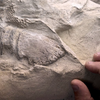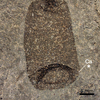Scientists Discover First Ever Ancient Roman Trilobite!

The newly discovered trilobite, fashioned into a pendant by a researcher!
Post Author- Ellis Nolan
It’s well known among archaeologists that the ancient Romans had a reverence for fossils. For example, it is thought they believed mammoth bones and teeth were those of dragons and cyclopes, and thus, these items were often displayed in places of power. However, researchers in Spain recently uncovered an exceedingly rare Roman fossil artifact from an unlikely place.
In Armea, an area in the northwest region of Spain, lay the ruins of an Ancient Roman settlement where researchers found a fossil trilobite, thought to be fashioned into either a pendant or bracelet adornment almost 2,000 years ago. While scientists have discovered ancient Roman jewelry created out of other fossil materials such as jet, amber, or ammonites, this is a particularly remarkable discovery, as it is the first Roman trilobite specimen ever found.
Furthermore, the Armea specimen is only the eleventh discovery of what researchers call an “archaeological fossil.” In other words, a fossil uncovered by pre-modern peoples being studied by archaeologists. It’s also only the third trilobite archaeological fossil discovered from over one thousand years ago.
When trilobite specimens are found, archaeological or not, they usually have large amounts of matrix (the rock around the fossil) along the bottom of the fossil. However, this specimen is unique, as it has essentially no matrix along the bottom, rather, it contains marks that suggest the fossil was shaped or carved to potentially fit a pendant casing of some kind.
Ancient Romans likely believed these trilobites to have healing or otherwise magical powers, and thus it would make sense that one would want to wear such an item. It’s even hypothesized that other Roman jewelry items, such as “channel beads,” made of jet, amber or other fossil materials, mimicked the shell patterns of trilobites, since they were believed to be objects of magical significance.
The fossil itself is what is known as a Reedocalymenine, a trilobite variation that skittered through the Ordovician seas about 1.5-2 million years ago. These fossils are found throughout the Iberian peninsula but are relatively rare as archaeological fossils as they are most often found encased in shale and thus difficult to break through without modern tools.
The researchers end their account by noting that the Armea specimen was found next to a coin featuring the Roman emperor Augustus, an avid fossil collector who is credited with starting the first ever paleontological museum in his home. Perhaps it’s a good omen for future finds!
Featured Product
Joe Frazier Boxing Glove
Cool Things!

Is “Paul is Dead” Dead?: Unpacking One Of Pop Culture’s Most Enduring Conspiracy Theories

Scientists Discover Hooves and Skin in Preserved Dinosaur "Mummies!"
A dinosaur discovery just in time for Halloween! In a new analysis of a group of fossils from Wyoming, Scientists have determined this group of fossils are dinosaur “mummies,” with preserved skin and even hooves.

Scientists Record a Bat Catching Birds Mid-Flight!
Bats, birds, screeches, oh my! In a reverse-Hitchcock twist, a new study reveals that a species of European bat catches and eats birds mid-flight.
Specimen Deep Dives

The House that Ruth Built: The Story of the Old Yankee Stadium

The Queen of the Skies: the Story of the Boeing 747

Old Ironsides: The USS Constitution and the Start of the U.S. Navy
Long Form Articles

The Artist Behind the Macintosh: Susan Kare and Apple Computers
While the two Steves, Jobs and Wozniak, are the most well known faces behind Apple computers, equally important to the products and culture of the company were those who crafted the experience of using their computers through design. The most notable of these visual architects was Susan Kare, a designer responsible for “humanizing” Macintosh computers.

Can I Lick It? Yes You Can!
Have you ever been unable to tell if a fossil was really a fossil, but you were too embarrassed to admit it? Have you ever wanted to lick a fossil just because, but you didn’t want to risk judgment from your peers? Well, good news! You can kill two birds with one stone! Licking a fossil can actually help you determine if it’s the real deal or just another rock.

Is It Legal To Own a Meteorite: How to Start Your Outer Space Collection!
Meteorites are some of the rarest geological specimens to be found on Earth. Of course, since these stones are not of our world, purchasing them can sometimes be a confusing process. Is it legal to own a meteorite? In short, yes! Read on for help starting your cosmic collection!

















